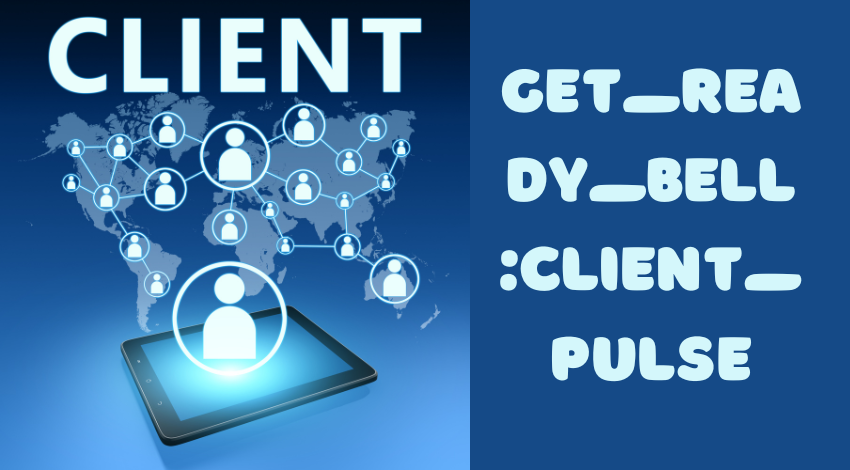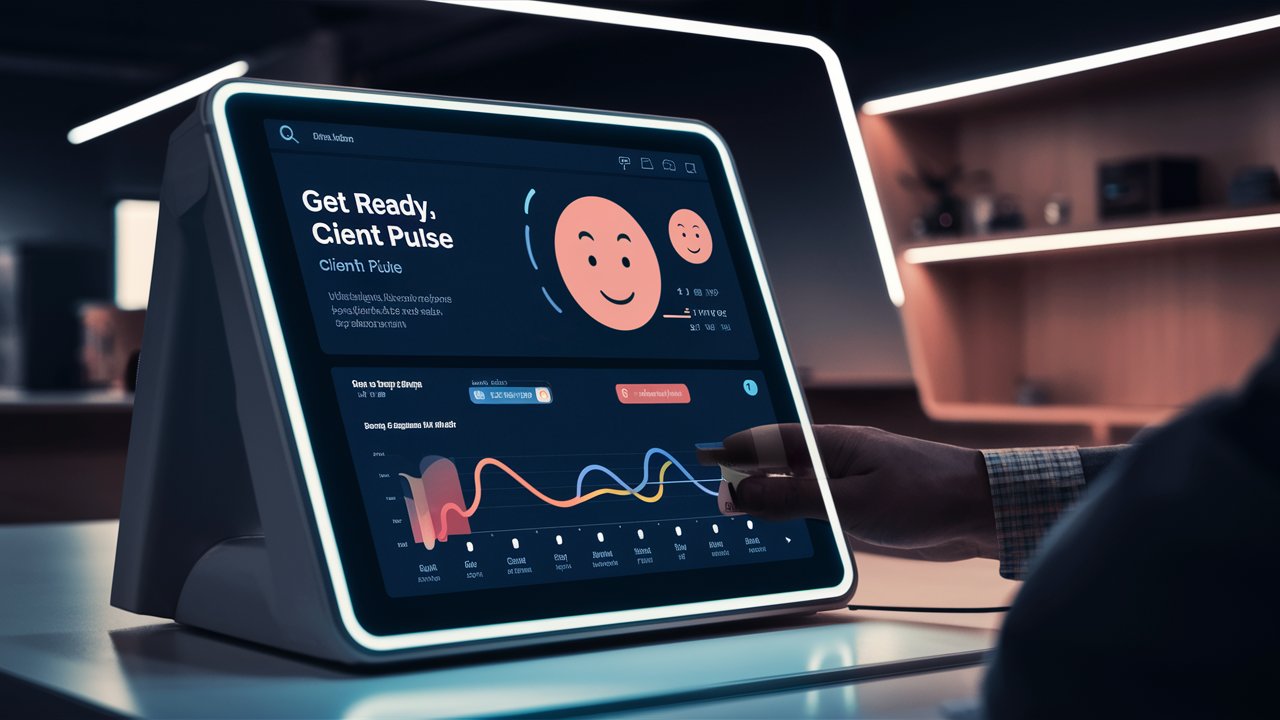Introduction
Get_ready_bell:client_pulse, In today’s fast-paced business environment, understanding and anticipating client needs is crucial for sustained success. The concept of “Client Pulse” has emerged as a significant strategy for maintaining client satisfaction and loyalty. Get_Ready_Bell, a leading business solutions provider, has pioneered the Client Pulse methodology, enabling businesses to stay ahead of the curve by continuously monitoring and adapting to client needs and feedback.

This article delves into the intricacies of Get_Ready_Bell’s Client Pulse, exploring its origins, methodology, benefits, implementation, and real-world applications.
1. The Genesis of Client Pulse
1.1. Background and Vision
The idea of Client Pulse was conceived by Get_Ready_Bell’s leadership team, who recognized the growing importance of client-centric business models. Traditional feedback mechanisms, such as annual surveys and quarterly reviews, were deemed insufficient in capturing the dynamic nature of client expectations. The vision behind Client Pulse was to create a continuous feedback loop that would provide real-time insights into client satisfaction and needs.
1.2. Evolution and Development
Since its inception, the Client Pulse methodology has evolved significantly. Initially, it focused on basic satisfaction metrics, but over time, it has incorporated advanced analytics, artificial intelligence (AI), and machine learning (ML) to provide deeper insights and predictive capabilities. This evolution has positioned Get_Ready_Bell as a leader in client relationship management.
2. Understanding Client Pulse
2.1. Definition and Objectives
Client Pulse refers to a systematic approach to monitoring and understanding client sentiments, behaviors, and needs in real-time. The primary objectives of Client Pulse are to:
- Continuously gather client feedback.
- Analyze feedback to identify trends and patterns.
- Predict future client needs and behaviors.
- Implement proactive measures to enhance client satisfaction and loyalty.
2.2. Key Components
The Client Pulse methodology comprises several key components:
- Feedback Collection: Utilizing various channels, including surveys, social media, and direct interactions, to gather client feedback continuously.
- Data Analytics: Employing advanced analytics tools to process and analyze the collected data.
- Sentiment Analysis: Leveraging AI and ML to interpret client sentiments and emotions from feedback.
- Actionable Insights: Translating data analysis into actionable insights for business improvements.
- Proactive Measures: Implementing changes based on insights to address client needs and enhance satisfaction.
3. Benefits of Client Pulse
3.1. Enhanced Client Satisfaction
By continuously monitoring client feedback, businesses can promptly address issues and concerns, leading to higher levels of client satisfaction. This proactive approach ensures that clients feel heard and valued.
3.2. Increased Client Retention
Satisfied clients are more likely to remain loyal. Client Pulse helps in identifying potential churn risks early, allowing businesses to take corrective actions to retain clients.
3.3. Improved Product and Service Quality
The insights gained from Client Pulse can drive improvements in product and service offerings. By understanding client needs and preferences, businesses can tailor their offerings to better meet expectations.
3.4. Competitive Advantage
Businesses that implement Client Pulse can differentiate themselves from competitors by demonstrating a strong commitment to client-centricity. This competitive edge can lead to increased market share and revenue growth.
3.5. Informed Decision-Making
Client Pulse provides businesses with valuable data that can inform strategic decision-making. Whether it’s product development, marketing strategies, or customer service enhancements, the insights from Client Pulse guide businesses towards making informed choices.
4. Implementation of Client Pulse
4.1. Initial Setup
The implementation of Client Pulse begins with setting up the necessary infrastructure for feedback collection and data analysis. This includes selecting appropriate tools and technologies, defining key metrics, and establishing a feedback collection process.
- Tools and Technologies: Businesses can use a combination of survey platforms, CRM systems, social media monitoring tools, and analytics software.
- Key Metrics: Defining metrics such as Net Promoter Score (NPS), Customer Satisfaction Score (CSAT), and Customer Effort Score (CES) is crucial.
- Feedback Collection Process: Establishing a systematic process for collecting feedback through various channels.

4.2. Data Collection and Analysis
Once the setup is complete, the next step is to collect and analyze client feedback continuously. This involves:
- Surveys: Regularly sending out surveys to clients to gather their feedback on various aspects of the business.
- Social Media Monitoring: Tracking client interactions and mentions on social media platforms to gauge sentiments.
- Direct Interactions: Collecting feedback from direct interactions with clients, such as customer service calls and meetings.
- Analytics: Using analytics tools to process the collected data and generate insights.
4.3. Sentiment Analysis and Predictive Analytics
Advanced AI and ML algorithms are employed to perform sentiment analysis and predictive analytics. These technologies help in understanding the emotions behind client feedback and predicting future behaviors and needs.
- Sentiment Analysis: Analyzing text from feedback to determine positive, negative, or neutral sentiments.
- Predictive Analytics: Using historical data to forecast future client behaviors and trends.
4.4. Generating Actionable Insights
The insights generated from data analysis are then translated into actionable recommendations. This involves:
- Identifying Trends and Patterns: Recognizing recurring themes and issues in client feedback.
- Prioritizing Actions: Determining which issues require immediate attention and which can be addressed later.
- Developing Action Plans: Creating detailed plans to implement the necessary changes based on insights.
4.5. Implementation of Changes
The final step is to implement the changes and monitor their impact. This includes:
- Executing Action Plans: Carrying out the changes as per the developed plans.
- Monitoring Impact: Continuously monitoring the impact of the changes on client satisfaction and business performance.
- Adjusting Strategies: Making adjustments to strategies and plans based on ongoing feedback and results.
5. Real-World Applications
5.1. Case Study 1: Improving Customer Service
A leading telecommunications company implemented Client Pulse to enhance its customer service. By continuously monitoring client feedback, the company identified key pain points, such as long wait times and unresolved issues. Using these insights, the company revamped its customer service processes, reduced wait times, and provided additional training to service representatives. As a result, customer satisfaction scores increased significantly.
5.2. Case Study 2: Product Development
A software development firm used Client Pulse to gather feedback on its new product features. The continuous feedback loop enabled the firm to quickly identify which features were well-received and which needed improvement. By prioritizing and addressing client feedback, the firm was able to release updates that better aligned with client needs, leading to higher adoption rates and positive reviews.
5.3. Case Study 3: Reducing Client Churn
An online retail company implemented Client Pulse to monitor client satisfaction and predict churn risks. The predictive analytics component of Client Pulse identified clients who were at risk of leaving based on their feedback and purchasing behavior. The company then launched targeted retention campaigns, offering personalized discounts and resolving issues proactively. This approach resulted in a significant reduction in client churn.
6. Challenges and Solutions
6.1. Data Privacy and Security
One of the major challenges in implementing Client Pulse is ensuring data privacy and security. Businesses must comply with data protection regulations and safeguard client information.
- Solution: Implement robust data security measures, such as encryption and access controls, and ensure compliance with regulations like GDPR and CCPA.
6.2. Integrating Feedback Channels
Another challenge is integrating multiple feedback channels to create a unified view of client feedback.
- Solution: Use integrated CRM systems and analytics platforms that can consolidate data from various sources and provide a comprehensive view of client feedback.
6.3. Managing Volume of Data
The continuous collection of feedback can result in a large volume of data, making it challenging to analyze and derive insights.
- Solution: Employ advanced analytics tools and AI/ML algorithms to efficiently process and analyze large datasets, and focus on key metrics that matter most.
6.4. Ensuring Actionable Insights
Not all feedback may be actionable, and businesses might struggle to prioritize and implement changes.
- Solution: Develop a clear framework for prioritizing feedback and translating insights into specific, actionable recommendations. Engage cross-functional teams to ensure effective implementation of changes.

FAQ
1. What is Get_Ready_Bell: Client Pulse?
Answer: Get_Ready_Bell: Client Pulse is a continuous feedback and analysis system designed to monitor and understand client sentiments, behaviors, and needs in real-time. It aims to help businesses improve client satisfaction, retention, and overall service quality.
2. How does Client Pulse work?
Answer: Client Pulse works by collecting feedback from various channels, such as surveys, social media, and direct interactions. This feedback is then analyzed using advanced analytics, sentiment analysis, and predictive algorithms to generate actionable insights.
3. What are the main benefits of using Client Pulse?
Answer: The main benefits include enhanced client satisfaction, increased client retention, improved product and service quality, competitive advantage, and informed decision-making based on real-time client feedback.
4. What types of businesses can benefit from Client Pulse?
Answer: Any business that values client feedback and aims to improve its client relationships can benefit from Client Pulse. This includes industries such as telecommunications, retail, software development, healthcare, and financial services.
5. How often is feedback collected through Client Pulse?
Answer: Feedback is collected continuously, allowing businesses to monitor client sentiments and needs in real-time. This can be done through automated surveys, social media monitoring, and direct client interactions.
6. What tools are used to collect and analyze feedback in Client Pulse?
Answer: Client Pulse utilizes a combination of survey platforms, CRM systems, social media monitoring tools, and advanced analytics software to collect and analyze client feedback.
7. How is client data protected in Client Pulse?
Answer: Client data is protected through robust security measures such as encryption, access controls, and compliance with data protection regulations like GDPR and CCPA.
8. Can Client Pulse predict client behavior?
Answer: Yes, Client Pulse employs predictive analytics to forecast future client behaviors and needs based on historical data and current feedback trends.
9. How are actionable insights generated from the feedback?
Answer: Actionable insights are generated by analyzing the feedback to identify trends and patterns. Advanced analytics tools and AI/ML algorithms help translate these patterns into specific, actionable recommendations for business improvements.
10. What is sentiment analysis, and how is it used in Client Pulse?
Answer: Sentiment analysis is the process of interpreting and classifying emotions within client feedback. In Client Pulse, sentiment analysis helps determine whether feedback is positive, negative, or neutral, providing deeper insights into client sentiments.
11. How can businesses implement the changes suggested by Client Pulse?
Answer: Businesses can implement changes by developing detailed action plans based on the insights provided by Client Pulse. This includes prioritizing actions, executing plans, monitoring impact, and making necessary adjustments.
12. How does Client Pulse improve client satisfaction?
Answer: By continuously monitoring and addressing client feedback, businesses can resolve issues promptly, meet client expectations more effectively, and demonstrate a commitment to client-centricity, all of which contribute to higher client satisfaction.
13. Can Client Pulse help reduce client churn?
Answer: Yes, Client Pulse can help reduce client churn by identifying potential churn risks early and allowing businesses to take proactive measures to retain clients, such as personalized offers and resolving issues proactively.
14. What kind of metrics are tracked in Client Pulse?
Answer: Key metrics tracked in Client Pulse include Net Promoter Score (NPS), Customer Satisfaction Score (CSAT), and Customer Effort Score (CES), among others.
15. How does Client Pulse integrate with existing business systems?
Answer: Client Pulse integrates with existing business systems through APIs and compatible software solutions, ensuring seamless data flow between feedback collection tools, CRM systems, and analytics platforms.
16. What challenges might businesses face when implementing Client Pulse?
Answer: Challenges include ensuring data privacy and security, integrating multiple feedback channels, managing large volumes of data, and translating feedback into actionable insights.
17. How can these challenges be overcome?
Answer: These challenges can be overcome by implementing robust security measures, using integrated CRM and analytics platforms, employing advanced data processing tools, and developing a clear framework for prioritizing and acting on feedback.
18. Can Client Pulse be customized for different industries?
Answer: Yes, Client Pulse can be customized to meet the specific needs and requirements of different industries, ensuring relevant metrics, feedback channels, and analytical tools are used.
19. How do businesses measure the success of Client Pulse?
Answer: Success is measured by tracking improvements in client satisfaction scores, retention rates, and overall business performance metrics. Continuous monitoring and adjustments based on ongoing feedback also contribute to measuring success.
20. What are some real-world applications of Client Pulse?
Answer: Real-world applications include improving customer service in telecommunications, enhancing product development in software firms, and reducing client churn in online retail. These examples demonstrate how Client Pulse helps businesses achieve tangible results by addressing client needs proactively.
Conclusion
Get_Ready_Bell’s Client Pulse represents a paradigm shift in how businesses approach client relationship management. By continuously monitoring and analyzing client feedback, businesses can stay attuned to client needs, enhance satisfaction, and foster loyalty. The comprehensive methodology of Client Pulse, coupled with advanced analytics and proactive measures, equips businesses with the tools they need to thrive in a competitive market. As client expectations continue to evolve, adopting a client-centric approach like Client Pulse will be crucial for sustained success and growth. Whether you are a small business or a large enterprise, implementing Client Pulse can provide you with a significant competitive advantage, helping you build stronger, more meaningful relationships with your clients.






